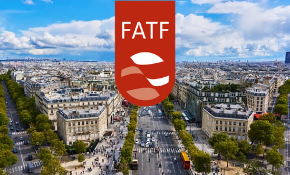An important study on the phenomenon of terrorism in Europe has recently been published by RUSI EUROPE (Royal United Services Institute), an international security and defense research organization based in the UK.
RUSI Europe's Study on Terrorism in Europe
First of all, RUSI is the UK Security and Defence Research Institution, established in 1831, and the most important, oldest, and authoritative institution studying counter-terrorism dynamics in Europe. The two institutions, the European Union and RUSI, have launched a project called FRAAC - Collaboration, Research, and Analysis against Terrorist Financing. This project is financed by the European Union's Internal Security Fund. In addition, the international security bodies GLOBSEC and ICCT (International Centre for Counter-Terrorism) also participate in this project.
Project CRAAFT is academic research and community-building initiative designed to build stronger, more coordinated counter-terrorist financing (CTF) capacity across the EU and in its neighborhood. The project engages with authorities and private entities in order to promote cross-border connectivity and targeted research.
The above-mentioned study conducted by the two RUSI counter-terrorism experts, Dr. Stephen Reimer and Dr. Matthew Redhead, examines 37 interviews, 106 cases of terrorism between January 2015 and November 2020, and four states involving England, France, Sweden, and Germany. The paper aims to examine two phenomena that may appear to be seemingly autonomous but find a union; they are terrorist financing activity and the peculiar terrorist conduct known by experts as Self- Activation.
The research carried out by RUSI attempts to answer two fundamental questions:
- What are the economic sources and modes of operation of terrorists active in Europe?
- Is the current CFT regulatory system adequate to counter these new dynamics of terrorism?
In order to understand this better, it is necessary to put the two institutions in context:
Terrorist financing means the activity whereby an individual or an organization, with political, social, or religious aims, accumulates money or goods (not necessarily of unlawful origin) in order to carry out acts of terrorism. In fact, as in the case of money laundering, where the goods are of unlawful origin and are converted and reused in the lawful market by means of three phases, also the crime of terrorist financing consists of three phases.
Stage 1: Collection: the agent starts to collect money; in some cases, there is the passage of the asset to the main collector.
Stage 2: Transmission and concealment (transmission/dissimulation), such as the use of the Hawala technique.
Stage 3: Use: the individual or organization subsequently uses the money to buy weapons, drugs, or products to create explosive mixtures.
After the attacks of 11 September 2001 in the United States, the fight against terrorism has changed radically; in a short time, the United States launched several regulatory and operational projects aimed at identifying and countering any terrorist organization also on the economic profile by countering the activity of financing terrorism (CFT), with this we need only think of the financial prevention through the 40 FATF recommendations. But that same mode of action, in our day and age, is now a thing of the past.
Even today, international organizations such as Daesh, Islamic State, and Al-Qaeda threaten the West through targeted attacks, spurring their followers to commit acts of terrorism. If before the attacker was enlisted and then sent on a mission to a place, now it is the perpetrator of the terrorist act himself who determines the initiation, planning, and execution, all autonomously deciding where, when, and how to carry out the terrorist act, that is why they are called Self-Activation (self-activators) They partially isolate themselves from a root to operate autonomously. The terrorist financing system in the face of this new activity has changed. If, before, the common international terrorist organizations financed by sending money, this has changed. It is the perpetrators of the terrorist acts themselves who are looking for economic sources and how to use the money.
Terrorist Finance's Economic Sources
The main economic sources identified by the two researchers generally concern the use of monetary financial instruments (cash and legal tender) or digital ones, such as the use of well-known virtual currencies to buy raw materials or devices for the purpose of terrorism. The perpetrators also resort to the cryptocurrency market in the Dark Web, but also more commonly to prepaid cards, the use of foreign accounts containing more flexible contractual policies such as anonymity, as well as the simple opening of an account in a tobacco shop (e.g., the Nickel payment system). However, the perpetrators do not always rely on the common banking system to receive and send money but resort to para banking or fictitious systems, miscommunicating their identity and keeping it hidden, for instance, by using pseudonyms. In some cases, researchers have discovered that relatives and friends of terrorists were behind the opening of bank accounts. The purpose of all these actions is to make them lose their economic traceability, thus not allowing them to reconstruct who the actual owners of their economic transactions are, thus circumventing Know Your Customer (KYC) and AML regulations. For example, this is the case of the Abedi brothers, perpetrators of the Manchester Arena bombing in 2017; the bomb had been built with several bank withdrawals from the HSBC bank in the name of their mother.
In fact, the further differences between the conduct of money laundering and that of financing terrorism concerns, first of all, the provenance and then the economic quantity that the attackers accumulate to carry out the crime. In the first case, the sums undergo a process of "washing" from illicit provenance to lawful use (not always), and we are talking about very high figures. On the other hand, in order to finance terrorism, which makes it more dangerous, the illicit provenance of the sums is not necessary, and a terrorist attack can be prepared even with a few hundred dollars.
What is more worrying, however, is the dangerousness of the perpetrators, insofar as in some terrorist events, malicious conduct has been identified, (apparently) premeditated in a short time and, above all, voluntary in misleading the police and financial vigilance authorities, concealing and deceiving the financial traceability; for example, with the so-called smurfing technique (splitting a capital into small sums), or taking money deriving from illicit activities such as drugs, arms Cf. the case of the Kouachi Brothers) so as not to have declarative documentation of the economic operation but also of lawful and legitimate economic sources (which, according to the study, are 80% of the terrorist attacks examined) such as the indirect or direct perception of State funds: for example, public income for pension purposes, income due to unemployment, citizenship income, or income from self-employment and employment.
With regard to the economic sources, for example, consider what happened in Italy in December 2020; the Guardia di Finanza discovered in the city of Bologna two citizens of Tunisian origin who were financing terrorism using the income of citizenship, discovering suspicious transactions for a total amount of almost 12,000 euros transferred to Tunisia, to a dangerous person on the Belgian anti-terrorism list. A further example cited in the paper is the case of Mohamed M., dating back to the 2019 terrorist events in Lyon, who purchased explosives while carrying out online tutoring activities.
It is necessary to state, also in the RUSI study, that the economic sources that subsequently determine the financing of terrorism are not based on a single source but rather a hybrid of several sources, licit and illicit, for which the study asks the international community to provide specific guidelines.
The Dangers of Self-Activating Terrorists: Understanding the Behaviour of Lone Wolves
It is important to address, albeit briefly, this issue; this is because it is inseparable that whoever finances terrorism or whoever is preparing to commit an attack, the author does not try to deceive or simulate by putting in place countermeasures, not to create suspicion towards the authorities, even under a 'normal' behavioral profile, such as lifestyle, social activities.
The work of these Self-Activators is solitary; they try not to involve anyone unless strictly necessary. Sometimes small groups (terrorist cells) have been discovered, with a maximum of 2-3 people. In some cases, however, it has been found that not only the well-known terrorist figure of the Foreign Fighters is more dangerous, but some particular subjects are also called "lone wolves." Furthermore, these subjects are considered, by intelligence and security agencies, to be ghosts insofar as it is not known clearly where they are and what they look like.
In fact, according to the study, self-activating terrorists have a particular explosive behavior called 'Burst.' In general, they are dormant figures who try to avoid creating any possible suspicion toward them. They lead normal lives, not missing any daily and routine appointments, work, and private life. But at a certain point, anomalies occur, and large amounts of money are spent, which is why this article focuses on premeditated savings over time. For example, in the preparation phase, they simulate common purchases such as chemical products for cleaning and pest control, for the kitchen, and material inherent to their private or working life, but which instead turn out to have been used to commit an act of terrorism.
The Tools Used in Terrorist Attacks
The study analyses what could be the objects or tools used by the attacker. According to the study, 40 % of the terrorist events examined involved the use of bladed weapons (knives or machetes), 20 % involved the use of explosives known as IEDs (Improvised Explosive Devices), and 12 % involved the use of one or more vehicles (car, caravan, caravan, etc.). IED (Improvised Explosive Device), 12 % were found to have used one or more vehicles (stolen or rented cars, vans, trucks), and 12 % used firearms such as automatic pistols and rifles.
Conclusions: A Necessary Reform In The Field of CFT
The paper presented, consisting of about fifty pages, analyses the regulatory developments that have been made over time to counteract the conduct of terrorism financing thanks to the international authority FAFT. In particular, the RUSI proposes to make greater preventive controls on two macro areas: the first an even deeper knowledge of the client towards a greater knowledge of identity. The other area concerns collaboration expressed, however, in the words of monitoring and reporting of all these indicators previously discussed. However, it remains an important goal that for some years now has been in a state of "work in progress," both on the international and national profile of individual states in the fight against terrorist financing. In addition, the prevention of terrorist financing starts with the work of the FIU in processing sensitive data working in close synergy with other state authorities at home and abroad, and strengthening immediate and comprehensive information exchange.
Finally, raising awareness in the judiciary of the importance of providing harsher penalties and sanctions for those who commit or attempt to commit any act of terrorism and more effective rehabilitation paths for those who commit this crime.





